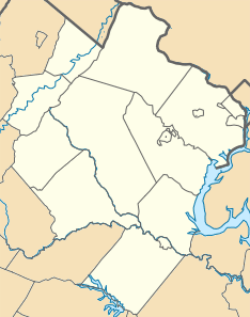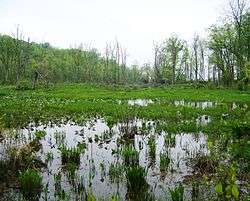Mason Neck, Virginia
| Mason Neck, Virginia | |
|---|---|
| Census-designated place | |
|
Wetlands in Mason Neck State Park | |
 Mason Neck  Mason Neck  Mason Neck Location within Fairfax county | |
| Coordinates: 38°39′23″N 77°10′45″W / 38.65639°N 77.17917°WCoordinates: 38°39′23″N 77°10′45″W / 38.65639°N 77.17917°W | |
| Country | United States |
| State | Virginia |
| County | Fairfax |
| Area | |
| • Total | 20.0 sq mi (51.9 km2) |
| • Land | 13.9 sq mi (35.9 km2) |
| • Water | 6.2 sq mi (16.0 km2) |
| Elevation | 20 ft (6 m) |
| Population (2010) | |
| • Total | 2,005 |
| • Density | 145/sq mi (55.9/km2) |
| Time zone | Eastern (EST) (UTC-5) |
| • Summer (DST) | EDT (UTC-4) |
| FIPS code | 51-49998 |
| GNIS feature ID | 2584877 |
Mason Neck is a peninsula jutting into the Potomac River to the south of Washington, D.C., in the U.S. state of Virginia. It is surrounded by Belmont Bay to the west, the Potomac River to the south and east, Gunston Cove to the northeast, and Pohick Bay to the north-northeast. The census-designated place (CDP) of Mason Neck forms the southernmost section of Fairfax County, in northern Virginia, and comprises an area of 20.0 square miles (51.8 km2),[1] two-thirds of which is preserved as parkland by regional, state, and national authorities. The population of the Mason Neck CDP was 2,005 as of the 2010 census.[1]
History
The Mason Neck peninsula was inhabited by the Doeg tribe prior to the arrival of European settlers. The recorded history of Mason Neck began around 1755 with the construction of Gunston Hall, the plantation house of George Mason, author of the Virginia Declaration of Rights. Mason Neck is also the location of Pohick Church, frequented by both Mason and George Washington, and Cranford Methodist Church, which was built in 1857 and served as a hospital during the Civil War.
During the 19th and early 20th centuries, much of the land was used for the logging of mature pine and hardwood timber. Over time, pollution and habitat destruction caused a decline in the bald eagle population. By the 1960s, much of the forest had grown back, but residential development as a suburb of Washington posed another threat. In 1969, local residents and conservation groups achieved the establishment of the Elizabeth Hartwell Mason Neck National Wildlife Refuge, with the specific objective of protecting the bald eagle.[2] This, along with Mason Neck State Park and Pohick Bay Regional Park, provides a variety of recreational activities while preserving the land's natural resources.
During the 1980s, the Lynch family traded Fairfax County officials their Mason Neck land holdings in exchange for 900 acres (360 ha) of land near the Lorton Prison. This plot of land became the housing development known as Crosspointe. Many of the suburban subdivisions located around the Lorton Prison are built on land that the Lynch family once owned. The Mason Neck land that was traded to the county later became a state-controlled nature reserve called Meadow Woods.
Wildlife
In addition to bald eagles, Mason Neck is home to a variety of animal species. Birds include great blue herons, Canada geese, ospreys, wood ducks, teal, owls, and woodpeckers. Whitetail deer are common, along with beavers, muskrats, groundhogs, and foxes. A diverse population of frogs and toads can be heard on summer nights. Eastern box turtles, eastern snapping turtles, wood turtles, and spotted turtles can all be found around ponds, streams, and marshes, as well as snakes, such as the northern copperhead and the northern black racer.
References
- 1 2 "Geographic Identifiers: 2010 Demographic Profile Data (G001): Mason Neck CDP, Virginia". U.S. Census Bureau, American Factfinder. Retrieved October 13, 2016.
- ↑ "About the Refuge". Elizabeth Hartwell Mason Neck National Wildlife Refuge. U.S. Fish & Wildlife Service. Retrieved October 13, 2016.

